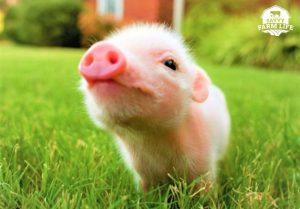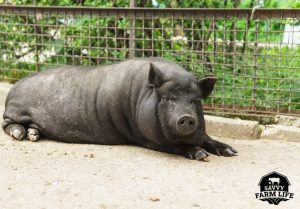
What is the Average Lifespan of a Pig?
There are close to 800 million farm pigs in the world, and another 7-8 million feral pigs. Pigs are not only highly intelligent (and cute), but are also big business. Whether a pasture pet or a financial livelihood, if you are raising pigs you will need to know the average lifespan that you can expect your pig to reach.
How long do pigs live? Due to meat production, the average farm pig will live only 6 to 7 months. The potential lifespan of a farm pig, however, is 15 to 20 years. Feral pigs, on the other hand, have an average lifespan of only 1 to 2 years, with few living for more than 6 – 8 years of age for environmental reasons.
Whether you are raising pigs as pets or as a business operation, you will need to know what to expect when it comes to your pig’s longevity. Read on for more information on the lifespan of both domestic and feral pigs, on the age of peak production, and to learn about the oldest pig in recorded history.
Lifespan Differences Between Farm Pigs And Feral Pigs
There is a significant difference between the potential average lifespan of a farm pig and the potential average lifespan of a feral pig. Farm pigs and feral pigs are of the same species – in fact, most feral pigs are the descendants of farm pigs who either escaped their enclosures or were set free. The difference in potential average lifespan, then, are largely due to environmental variations.
Potential Lifespan Of A Farm Pig
There is one commodity for which pigs are raised, and that is their meat. Pigs are typically processed when they reach 250 – 300 pounds, and most modern pig breeds will reach this market weight at around 6 – 7 months of age. For this reason, the average lifespan of a farm pig will be much lower than the potential lifespan of a farm pig. If raised with a goal other than meat production, pigs raised by humans can live much longer – between 15 and 20 years.
Potential Lifespan Of A Feral Pig
Because feral pigs and farm pigs are of the same species, you can reasonably assume that a feral pig can live as long as a farm pig. In reality, however, feral pigs rarely live past 6 – 8 years years of age. Unlike their farm cousins, feral pigs live in the wild – with wild predators, wild diets, and (not-so-wild) humans and vehicles. While pigs are highly adaptable, many feral pigs fall prey to malnutrition, the natural elements, and vehicle collisions. Even more feral pigs are killed by predators – humans are not the only species who enjoy pork.
Feral pigs also have a high mortality rate during the first year of life, offset only by their unique ability to produce multiple large litters of piglets annually. It is estimated that 80% of piglets do not survive past 12 months of life. For the 20% who survive the first year of life, 30-40% of them will not live past 2 years. By the fifth year of life, the odds of surviving drop even further. If you include the mortality rate of young piglets, the average lifespan of a feral pig will be a mere 1 – 2 years.
How Can You Tell A Pig’s Age?
Modern pig breeds have been designed to grow rapidly to a market weight of 250-300 pounds within months. Because of this rapid growth, determining a young pig’s age is relatively straight-forward when taking the breed into account. Different breeds will mature at different rates, and to different weights. You can often determine a young pig’s age simply by measuring the length of the pig and/or weighing the pig before it has reached physical maturity.
Another way to determine a pig’s age is by the eruption (and replacement) of the pig’s teeth. The intervals in which a pig’s permanent teeth will erupt will vary by breed, and modern farm pigs will develop a mature set of teeth much earlier than feral pigs. This method is only relevant to younger pigs. Older pigs will typically show molar wear, though this is a less accurate way of determining age, as environment and genetics will play a large role in the wearing of the molars.
Peak Age For Pig Reproduction
Because there is big business in pigs, the peak age for reproduction in both boars (male pigs) and sows (female pigs) has been extensively researched. While pigs can theoretically reproduce well into old age, they will reach a peak age for reproduction at a relatively young age. Typically within an operation, pigs will be culled (removed from the herd) as their production begins to decline.
Peak Age For Boar
 While the responsibility of weaning and rearing piglets rests on the sow, boar have a large role to play in the success of an intended mating. The boar’s part in the mating is referred to as “servicing”. It is important to set a boar up for success during his first several services, and this is usually accomplished by pairing him with a gilt (female pig who has not yet produced a litter) or preferably a small, docile sow. A young boar with a successful and low-stress early experience will usually go on to become a productive mature boar.
While the responsibility of weaning and rearing piglets rests on the sow, boar have a large role to play in the success of an intended mating. The boar’s part in the mating is referred to as “servicing”. It is important to set a boar up for success during his first several services, and this is usually accomplished by pairing him with a gilt (female pig who has not yet produced a litter) or preferably a small, docile sow. A young boar with a successful and low-stress early experience will usually go on to become a productive mature boar.
While a mature boar can successfully service several sows, there is such a thing as “too mature” for the service pen. When breeding for specific traits, most pig farmers cull between 18 months and 2 years of age to speed up the genetic component of breeding. For this reason, and due to the size of mature pigs, most boars are culled at around 2 years of age.
While boar can productively breed beyond the age of 2, by 3-4 years of age a boar will often literally outweigh his usefulness. Physically mature boar will reach a significantly higher weight than young sows, and continued mating can cause physical injury to the sow. Because of the heaviness of the boar, he will also become more prone to leg weakness by this age, making the physical act of mating more difficult.
To learn more about the how male pigs mature, visit my article What a Male Pig is Called & Other Male Pig Facts.
Peak Age For Sows
There are few mammals that can rival the reproductive rate of pigs. Sows are easily able to produce two litters per year, with each litter averaging 10-15 piglets. This means that one sow can produce 20-30 (or more) piglets annually. While this is impressive, like boars, sows will reach their reproductive peak at a relatively young age.
Gilts should not be used for breeding during the first heat cycle, as this can negatively impact litter health and size for the remainder of her fertile years. For this reason, most pig farmers wait until the second or even third heat cycle before breeding gilts.
While each sow is an individual and litter quality will naturally vary, the reproductive cycle of a sow usually follows a typical pattern. A sow’s litter size will usually peak around her third litter (also referred to as “parity”) and will maintain this level of production into her fifth or sixth parity, at which time the litter size will begin to decline. For this reason, most pig farmers cull their sows some time after the fifth or sixth parity.
To learn more about pregnancy in pigs, visit my article When Can A Pig Get Pregnant? (& Other Pig Pregnancy Facts).
How To Extend The Life Of Your Pig
Though pigs are known to be resilient and hardy animals, there are a few measures that you can take to increase your pig’s chances of reaching an old age.
There are several predators that will happily take your pig off of your hands – coyotes, dogs, bears, mountain lions, and wolves to name a few. To keep your pigs safe, you will need a fence that will both keep predators out and pigs in. When it comes to fences, don’t focus solely on the height of the fence – pigs have strong snouts and will usually escape fences by rooting under them.
You will also want to be proactive with your pig’s health. Pigs can suffer from being both underweight and being overweight. It is important to provide adequate nutrition to keep your pig at a healthy weight. You will also want to speak with your vet or other local pig farmers to get information on how to keep your pig up-to-date on vaccinations and de-worming methods recommended in your locale.
How Old Was The Oldest Pig?
Remarkably, the oldest pig on record did not reach an age that is significantly beyond the pig’s potential lifespan. The oldest pig on record was named Baby Jane, and she lived to be 23 years and 7 months of age. Baby Jane was a pig kept as a family pet, and is considered by the Guinness Book of World Records to have been the oldest pig kept in captivity.
While 23 years is currently the record, there are many farmers who have raised pigs to reach the age of 20. Pigs are relatively hardy animals when compared to other livestock and if you provide proper care and nutrition, your pig might just be the next Baby Jane.
Did you know there are ways to tell if a pig is pregnant besides getting an ultrasound? To learn more, visit my article How to Tell if a Pig is Pregnant: Step-By-Step Guide.
